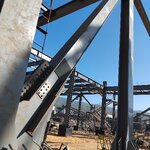Wani_1
Mechanical
- Apr 8, 2025
- 3
Hi, I was wondering what ways one would use to get an equal radius of gyration in both yy & zz axis of given cross sections.
I tried using 2 flat plates and I beam to achieve this by equating the desired radius of gyration to that of the highest radius of gyration of the I beam.
After some algebra, I got an uneconomical plate thickness (106mm).
Are there any other consideration made to achieve equal radius of gyration and reasonable thickness in my case?
Thanks.
I tried using 2 flat plates and I beam to achieve this by equating the desired radius of gyration to that of the highest radius of gyration of the I beam.
After some algebra, I got an uneconomical plate thickness (106mm).
Are there any other consideration made to achieve equal radius of gyration and reasonable thickness in my case?
Thanks.

